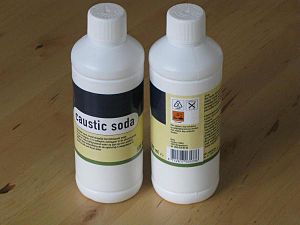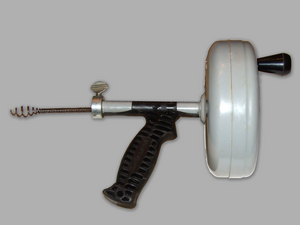By Billy Aldridge
We’ve all been there, trying to put our game face on
first thing in the morning, either trying to shave or fix our hair when we hear
that annoying sound coming at us from out of the bathroom sink. Glug, glug, glug. Or perhaps it last happened to you when you
finished doing the dishes and pulled the plug on the kitchen sink only to watch
as the water stubbornly refuses to go down.
You know what I’m talking about.
I call it the pain in the drain.
You may have some more colorful ways to describe the situation when it
happens to you. But like it or not,
drain clogs come to all of us from time to time. Sometimes they are the kind that you can
unclog them on your own and sometimes they are the stubborn kind that requires
professional help to clear. Well fear not, because in the next few minutes I am
going to show you the care and feeding of your household drains.
 |
| English: Drain cleaner as sold in the hardware shop which contains 99+% NaOH. (Photo credit: Wikipedia) |
In the first place the worst time to tackle the
problem is when the sink is stopped up.
More often than not, t
he pipes will give you subtle warning signs that a
stoppage is imminent, by either slowing the outflow of water to a crawl or by
making those strange intestinal noises, the ones most humans make after eating
either Cajun cuisine or hot chili. When
most people detect either of these problems they usually reach for one of those
caustic drain cleaners. This is their
first mistake. While this kind of
product might temporarily open up the drain, it also exposes you to two
potential dangers. The first is a
chemical burn you could self-inflict if any of the product gets on you. The second is erosion of and possible rupture
of your pipes that can come from repeated use of these products.
If you want to try a chemical solution to a slow
drain, try this no-caustic recipe that’s guaranteed not to burn you or your
pipes. Put ½ cup of baking soda mixed
with ¼ cup of salt into the drain.
Follow this by pouring ½ cup of vinegar.
Then let the mixture sit for 20 minutes and then run hot water for a
minute followed by cold water for one minute.
While this procedure won’t break up the most stubborn of clogs, it is a
recipe used in conjunction with a plunger can improve flow without harming
either you or the pipes.
Send
in the Snake
If your sink is completely stopped up and the
plunger won’t clear the clog, it’s time to send in the snake. Known as an auger in the trade, this is the
long slender contraption that fits down most drains and is capable of making it
around the tight turns in most pipes.
Some augers are meant to be used by hand and others are designed to be
attached to a drill or other motorized device.
Just as with caustic cleaners, you want to exercise caution when using
power augers. The last thing you want to
do is save some money on a drain cleaning job only to wind up in the ER.
 |
| English: Handheld Drain Auger (Photo credit: Wikipedia) |
Manual augers can be purchased at most any hardware
store. They usually come in 10-foot
lengths and have a t-shaped handle at one end and a coiled head at the
other. If the clog is located close to
the sink,
manual augers can be a godsend.
By simply threading the snake down the drain and turning the handle
these handy helpers are designed to grab and retrieve hairballs, grease wads
and other yuck that’s situated in the first few feet of pipe. However, if the clog isn’t located near the
drain you need to be aware that clearing a clog can take as much as 50 feet of
cable to reach and is not something that anyone but a professional should
attempt.
Preventative
Maintenance
Besides, with a little preventative maintenance, you
won’t need to call out the plumber so often.
One of the best ways to keep a drain clear and clean is to fill the sink
once per month to the top with hot water and a couple of drops of dish
detergent. Once the sink is full, pull
the plug and allow the hot water to run full tilt with the water still running
until the sink empties. You will know
that you have a happy drain if you see that little water spout come up in the
middle of the sink followed by a sound not unlike my nephew finishing off the
last of his slurpy. That means that your
pipes are able to handle the flow. You can also use the homemade drain cleaner
that I told you about above as a monthly maintenance measure as well. After all, clean pipes are happy pipes.
Next week I am going to show you how to clean out
the cleanouts in my latest DIY video. So
stay tuned and be safe. Always wear
goggles and gloves when handling any caustic substances. No pain in the drain is worth a hospital
stay.
Billy Aldridge is one of the Doctors of Plumbology at Aldridge and Sons Plumbing in Jacksonville, Florida. Visit his site at http://plumbing-jacksonville-fl.com for even more helpful hints and DIY videos.

I'd still rather pay a plumber to go trolling around in the drains. Ewww! Still, an ounce of preventative maintenance is still worth a pound of cure. I have been flushing out my sinks with hot soapy water every month and find it does help keep them running smoothly.
ReplyDeleteGood advice. Why is it that drains manage to imitate so many unappetizing body sounds?
ReplyDeleteIf your sink is completely stopped up and the plunger won't clear the clog, it's time to send in the snake. Known as an auger in the trade, this is ... drainauger.blogspot.com
ReplyDelete